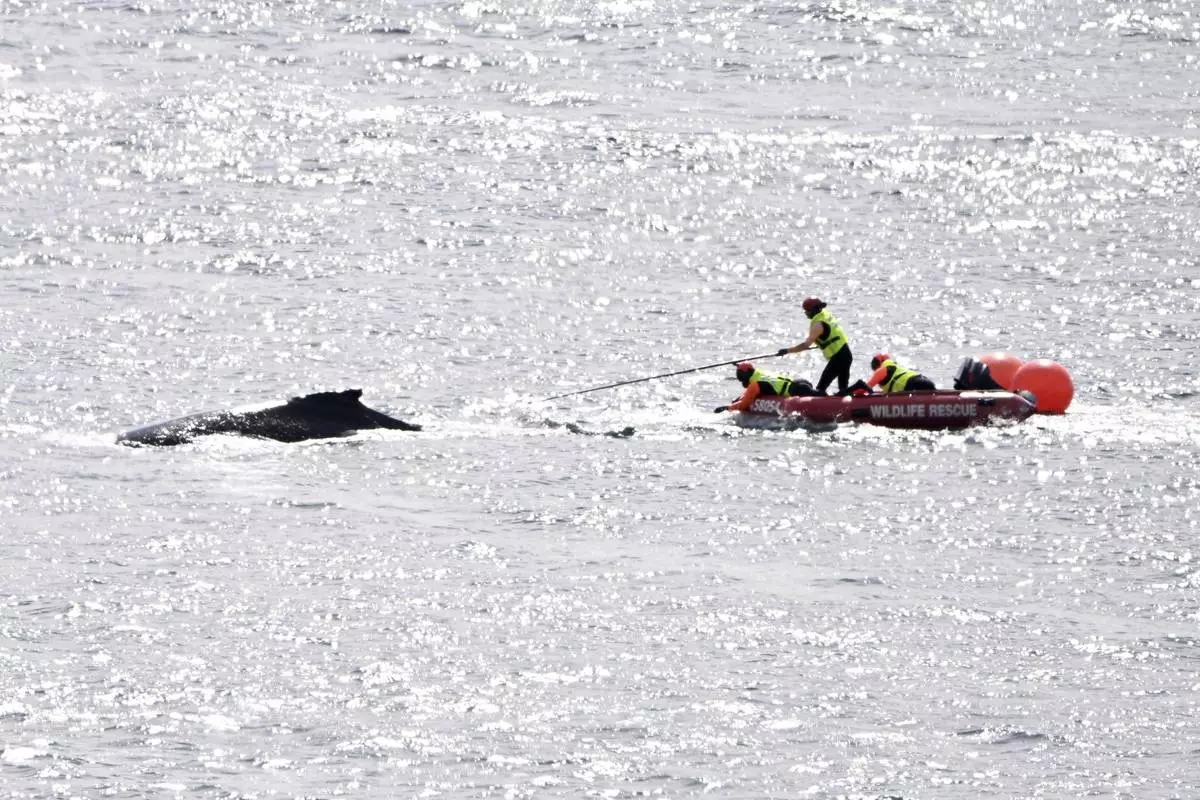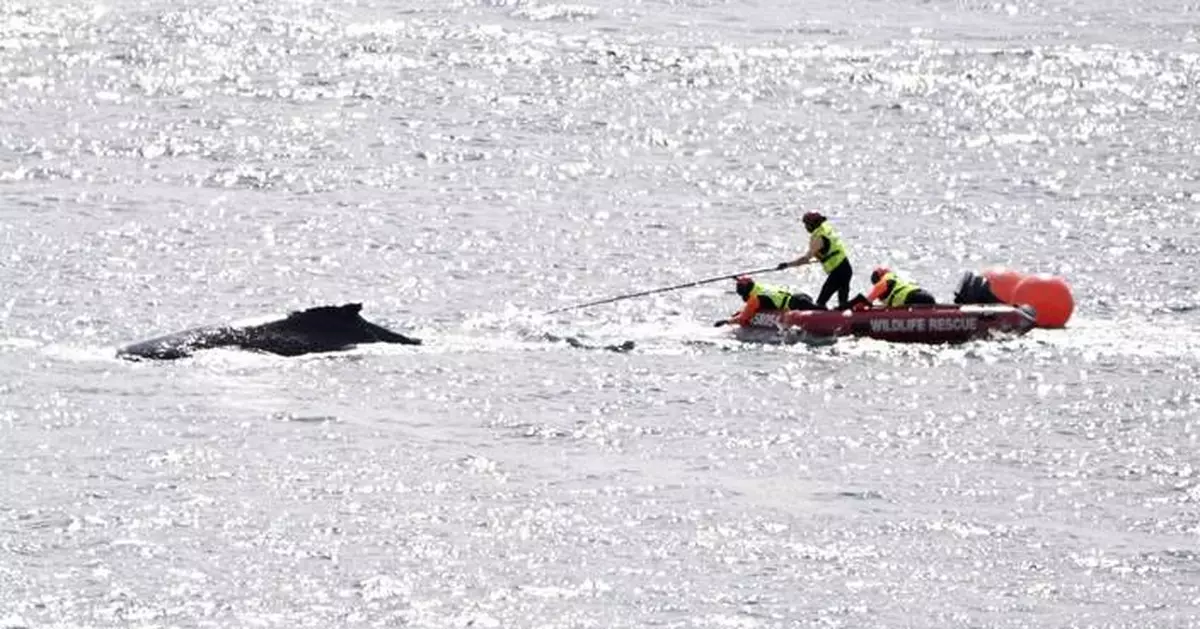MELBOURNE, Australia (AP) — A young humpback whale was freed from fishing tackle that had entangled its tail during an almost 24-hour rescue operation in Sydney Harbor.
The juvenile whale immediately began swimming toward the Sydney Heads and the open Pacific Ocean after government wildlife rescuers removed the ropes late Friday morning, Macquarie University whale expert Vanessa Pirotta said.
The distressed whale was first reported by operators of a whale watching cruise ship in the harbor at 1 p.m. on Thursday.
A rescue attempt involving boats, helicopters and drones began Thursday afternoon and resumed at first light Friday.
Pirotta said the whale could have become entangled far earlier than Thursday.
She could tell by the sound of the whale’s breathing that it was “very fatigued” before it was freed.
“Is the whale OK? I hope, I don’t really know. The reality is this animal has been through a huge ordeal,” Pirotta told Australian Broadcasting Corp.
“Being entangled in fishing gear is an awful thing, but then having boats and drones in the busiest harbor on Earth, Sydney Harbor — it’s just incredible to see where this has just unfolded,” Pirotta added.
Jessica Fox, an official from the volunteer Organization for the Rescue and Research of Cetaceans in Australia, said the rescue crew attached buoys to the tangled rope to slow the whale so they could eventually hold it in place while they cut the rope away.
“The whale has been going in circles in Sydney Harbor, making some erratic directional changes,” Fox said in video posted on social media on Friday before the mammal was freed.
“As you can imagine, it’s a very, very difficult task to try and disentangle a whale,” Fox added.
Pirotta said it was not clear why the whale had remained in the harbor rather than swim to the open ocean with its tail entangled. But staying in the harbor made rescuers’ job easier, she said.
A humpback whale is considered a juvenile up to 4 years old. Its gender is unknown.

Wildlife rescue workers attempt to release a humpback whale tangled in ropes in Sydney Harbour Friday, Aug. 23, 2024. (Dan Himbrechts/AAP Image via AP)
BOSTON (AP) — A study that explores the feasibility of using pigeons to guide missiles and one that looks at the swimming abilities of dead fish were among the winners Thursday of this year’s Ig Nobels, the prize for comical scientific achievement.
Held less than a month before the actual Nobel Prizes are announced, the 34th annual Ig Nobel prize ceremony at the Massachusetts Institute of Technology was organized by the Annals of Improbable Research magazine’s website to make people laugh and think. Winners received a transparent box containing historic items related to Murphy’s Law — the theme of the night — and a nearly worthless Zimbabwean $10 trillion bill. Actual Nobel laureates handed the winners their prizes.
“While some politicians were trying to make sensible things sound crazy, scientists discovered some crazy-sounding things that make a lot of sense,” Marc Abrahams, master of ceremonies and editor of the magazine, said in an e-mail interview.
The ceremony started with Kees Moliker, winner of 2003 Ig Noble for biology, giving out safety instructions. His prize was for a study that documented the existence of homosexual necrophilia in mallard ducks.
“This is the duck,” he said, holding up a duck. “This is the dead one.”
After that, someone came on stage wearing a yellow target on their chest and a plastic face mask. Soon, they were inundated with people in the audience throwing paper airplanes at them.
Then, the awards began — several dry presentations which were interrupted by a girl coming on stage and repeatedly yelling “Please stop. I'm bored.” The awards ceremony was also was broken up by an international song competition inspired by Murphy's Law, including one about coleslaw and another about the legal system.
The winners were honored in 10 categories, including for peace and anatomy. Among them were scientists who showed a vine from Chile imitates the shapes of artificial plants nearby and another study that examined whether the hair on people's heads in the Northern Hemisphere swirled in the same direction as someone's hair in the Southern Hemisphere.
Other winners include a group of scientists who showed that fake medicine that causes side effects can be more effective than fake medicine that doesn't cause side effects and one showing that some mammals are cable of breathing through their anus — winners who came on stage wearing a fish-inspired hats.
Julie Skinner Vargas accepted the peace prize on behalf of her late father B.F. Skinner, who wrote the pigeon-missile study. Skinner Vargas is also the head of the B.F. Skinner Foundation.
“I want to thank you for finally acknowledging his most important contribution,” she said. “Thank you for putting the record straight.”
James Liao, a biology professor at the University of Florida, accepted the physics prize for his study demonstrating and explaining the swimming abilities of a dead trout.
“I discovered that a live fish moved more than a dead fish but not by much,” Liao said, holding up a fake fish. “A dead trout towed behind a stick also flaps its tail to the beat of the current like a live fish surfing on swirling eddies, recapturing the energy in its environment. A dead fish does live fish things.”

Professor James Liao displays a stuffed fish while accepting a prize for physics for demonstrating and explaining the swimming abilities of a dead trout during a performance at the Ig Nobel Prize ceremony at Massachusetts Institute of Technology in Cambridge, Mass., Thursday, Sept. 12, 2024. (AP Photo/Steven Senne)

A team of researchers perform a demonstration during a performance showing that many mammals are capable of breathing through their anus while accepting the 2024 Ig Nobel prize in physiology at the Ig Nobel Prize ceremony at Massachusetts Institute of Technology, in Cambridge, Mass., Thursday, Sept. 12, 2024. (AP Photo/Steven Senne)

People in the audience throw paper airplanes toward the stage during a performance at the Ig Nobel Prize ceremony at Massachusetts Institute of Technology in Cambridge, Mass., Thursday, Sept. 12, 2024. (AP Photo/Steven Senne)

FILE - Students walk past the "Great Dome" atop Building 10 on the Massachusetts Institute of Technology campus in Cambridge, Mass, April 3, 2017. (AP Photo/Charles Krupa, File)














